Condition Report
Contact Information
Auction Specialist
Lot 39
Theodore Earl Butler
(American, 1861-1936)
Ferme de la Dîme, Giverny, 1909
Sale 2105 - American Art and Pennsylvania Impressionists
Dec 8, 2024
2:00PM ET
Live / Philadelphia
Own a similar item?
Estimate
$15,000 -
25,000
Price Realized
$24,130
Sold prices are inclusive of Buyer’s Premium
Lot Description
Theodore Earl Butler
signed T. E. Butler and dated (lower right)
23 1/4 x 28 1/4 in.
Property from a Private Collection, Denver, Colorado.
(American, 1861-1936)
Ferme de la Dîme, Giverny, 1909
oil on canvas
signed T. E. Butler and dated (lower right)
23 1/4 x 28 1/4 in.
Property from a Private Collection, Denver, Colorado.











